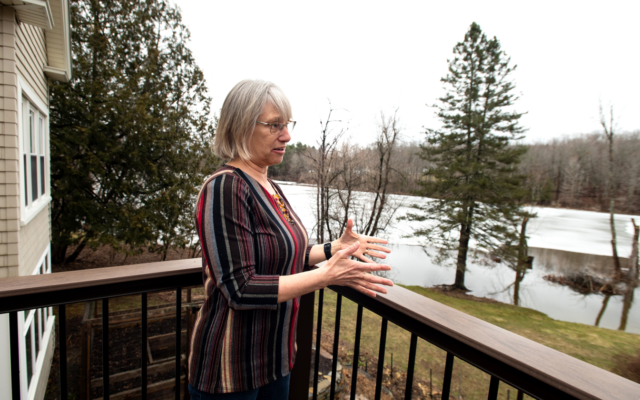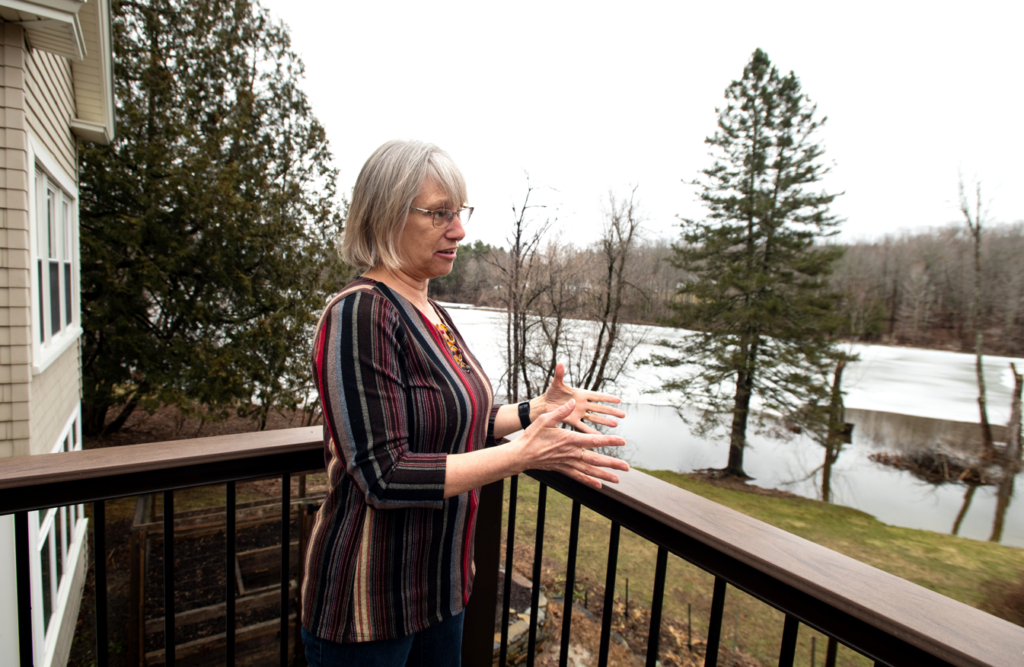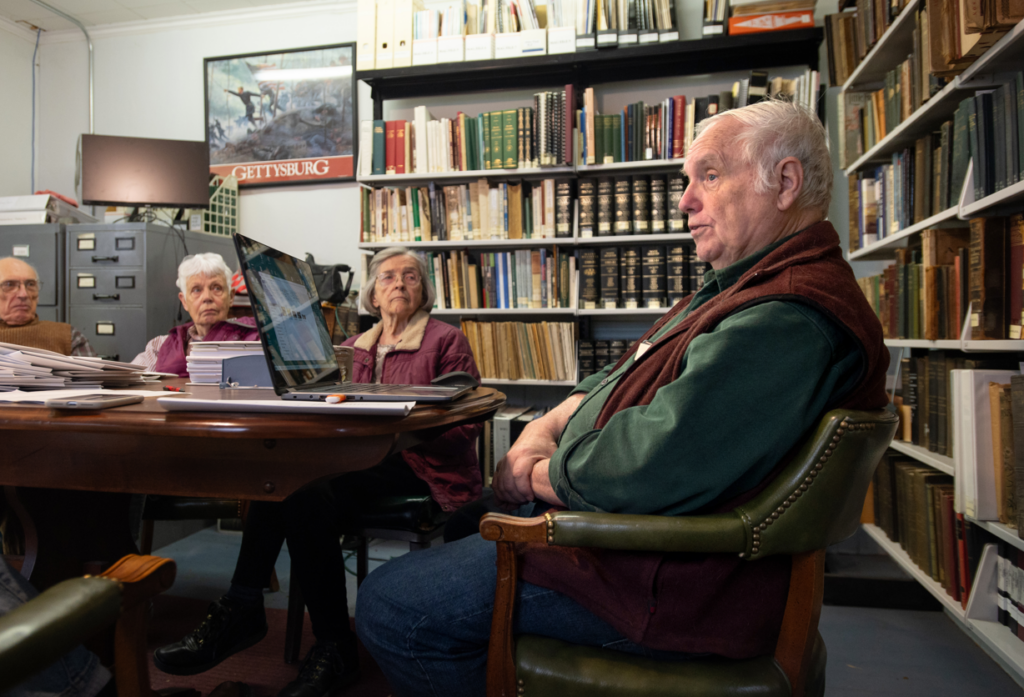
Dover-Foxcroft residents grapple with how dam removal could change their town
DOVER-FOXCROFT — Sandy Perkins and her husband, David, live in their dream retirement home along the Piscataquis River, where they can watch kingfishers and loons dive and bald eagles soar overhead. But their property could forever change if residents vote in June to remove the Mayo Mill dam downstream.
Even with the prospect of the river shrinking in front of property she and her husband have owned since 2011, Perkins doesn’t know how she’ll vote on the proposal to remove the dam and build a riverfront park.
The town committee tasked with finding a solution to the aging dam and connected facilities, says leaving the dam untouched is not an option. Whether the town decides to remove or restore it, both are expensive undertakings. Residents are grappling with questions about how removing the dam could reshape the town, whose history is deeply intertwined with the river.
Although some residents have strong opinions, for others the issue isn’t as simple as choosing whether they are for or against the project. Taxpayer money, the town’s character and access to nature are involved. Accepting that your home may change is complicated, several residents said during interviews Thursday.

FUTURE OF HER PROPERTY — Sandy Perkins, who lives along the Piscataquis River in Dover-Foxcroft, worries about what will become of the beauty in her backyard if a proposal to remove the Mayo Mill dam moves forward.
“I don’t think it’s the dam people want to keep. I think it’s this,” Perkins said, pointing out her window to the scenic view of the river, which families rely on for recreation year-round. “So I’m truly torn. I don’t know how I’ll vote.”
The Dover-Foxcroft Select Board in late February voted 6-1, with Joel Vail opposed, to accept the committee’s recommendation estimated to cost $20 million and send the issue to voters this summer.
Perkins read the committee’s detailed report, and she agrees with its reasons for removing the dam, she said. They include reducing flooding dangers, improving fish passage and the availability of funding to remove dams. That project alone is estimated to cost $6 million.
But there is no guarantee that a mudflat won’t replace the trickling river in her backyard when the project is completed, Perkins said, pointing to a presentation for abutters, which showed that water levels could drop drastically. It would be a tragedy if the town’s funding, which it still needs to secure, fell through or the vision didn’t pan out because once such beauty is gone, it cannot be replaced, she said.

MAYO MILL DAM — A committee responsible for finding a solution to the aging infrastructure of the Mayo Mill dam in Dover-Foxcroft proposed in January to remove the structure and build a riverfront park.
Perkins wished there was more confidence to seek funding for an option that proposed installing a nature-like fishway, though she acknowledged the construction estimate is more costly than removing the dam and it would be an ongoing expense for the town.
Dover-Foxcroft isn’t alone in considering removing aging infrastructure that some see as integral to the identity of a town. In the coastal community of Camden, a group has been trying to rally support for years to save the Montgomery Dam, which creates a photogenic series of waterfalls behind the downtown. A similar group, Friends of the Mayo Mill Dam, has formed in Dover-Foxcroft to preserve the town’s structure.
If residents vote down the dam removal item on the ballot in June, “the town will be in a hell of a pickle,” said Chris Maas, a member of the committee that studied the dam, along with the Atlantic Salmon Federation, the Nature Conservancy in Maine and Inter-Fluve. The town faces the possibility of spending millions of dollars to repair the dam, he said.
The town, which became owner of the dam in 2007 when Moosehead Manufacturing shuttered, has long failed to comply with the Federal Energy Regulatory Commission’s regulations, he said. During safety inspections in 2018 and 2023, the Federal Energy Regulatory Commission cited deficiencies with the dam, according to the committee’s report.

BOTH SIDES — Andrew Hutchins, who owns Sweet Lou’s Barber Shop in Dover-Foxcroft, sees both sides of the issue.
Over the years, the town consulted with engineers, turbine suppliers and a private developer to find a way to use the hydropower again, but it determined that none of the options were economically viable. Not even the owner and operator of the Brown’s Mill dam, also in town and which still produces power, wanted to invest in its rehabilitation.
Last year’s FERC inspection estimated it would cost the town $6 million to $8 million to address structural deficiencies and meet other regulatory requirements, and the agency stressed that addressing this was urgent, according to the dam committee’s report.
Although opinions about what to do with the dam were mixed when the committee formed, members agreed that the area should be a vibrant place for people to congregate downtown, said Maas, who also is a director at the Dover-Foxcroft Historical Society.
He believes there is a way for a future park to honor the dam’s history, which dates back to 1807, when it was built to power a sawmill and gristmill, long before Dover and Foxcroft combined into one town. The dam was rebuilt in 1920, then further refurbished in the 1980s, and over the decades it has powered a woolen mill, shingle mill, tannery and iron foundry, he said.

REASON FOR MOVING — Gary Guida said the dam’s aesthetic and historical value are important to him and are one of the reasons he moved to Dover-Foxcroft in December.
The committee’s study, funded by the salmon federation, looked at 23 options for the dam, which were eventually narrowed to two. One called for removal of the dam and powerhouse and the other for dam replacement, plus the installation of a nature-like fishway designed to simulate natural river channels and improve fish passage.
The dam’s aesthetic and historical value are important to Gary Guida. They’re among the reasons he moved from Brooks to Dover-Foxcroft in December. He’s willing to pay to keep the dam and restore its power again, he said.
“The argument is that it doesn’t cost us anything to have the dam removed because we’re going to throw ourselves at the foot of the federal government and let them take care of it,” he said. “Just because the government is willing to cost-share the project doesn’t mean it’s really the right thing to do.”
Rep. Chad Perkins, R-Dover-Foxcroft, thinks the committee went into the study with an open mind, but it worked with organizations that advocate for the removal of dams, he said. He’d like to see the dam stay so seaplanes can continue to land along the impoundment and residents can continue recreating throughout the year, among other reasons.

STEERING COMMITTEE — Chris Maas is a member of the committee that studied the dam with the Atlantic Salmon Federation, the Nature Conservancy in Maine and Inter-Fluve. He also is a director at the Dover-Foxcroft Historical Society.
He wants the Friends of the Mayo Mill Dam to explore alternatives to removal between now and June. Perkins said he will soon meet with the group to hear its perspectives and offer suggestions, though he is not a member.
“I’m a realist,” he said. “If we can get a less biased look at the process and it still comes down to removing the dam as the best option, I’m not going to fight that.”
Sylvia Dean, who was born and raised in town, observed that when many first heard about the removal proposal, their reaction was to resist change. She moved away in the late 1950s, returned in the late 1980s and now lives in neighboring Sangerville, though she is a director for Dover-Foxcroft’s historical society.
“All of their reasons were sentimental, and I thought the arguments were very limited,” she said. “I think my years away softened my response.”
The town has pursued downtown revitalization adjacent to and within the study area for two decades, according to the report. It’s positive that the committee is thinking of ways to boost Dover-Foxcroft’s economy, said Andrew Hutchins, who owns Sweet Lou’s Barber Shop downtown. In the same breath, he relates for those wishing to preserve the picturesque view of water rushing over the dam and the “small-town America” vibe it gives Dover-Foxcroft.
It could be wise to take advantage of federal funds now versus leaving a younger generation, including his two daughters, to pay for dam removal down the line, he said.
“If we let our emotions dictate what we do,” Hutchins said, “is it going to allow the forward motion that the town needs?”